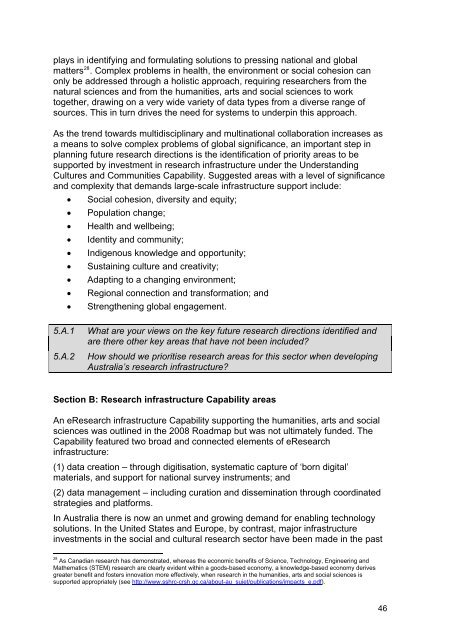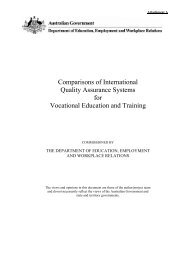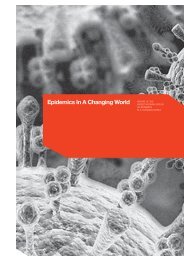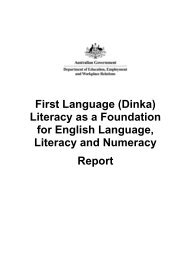2011 Strategic Roadmap for Australian Research Infrastructure
2011 Strategic Roadmap for Australian Research Infrastructure
2011 Strategic Roadmap for Australian Research Infrastructure
You also want an ePaper? Increase the reach of your titles
YUMPU automatically turns print PDFs into web optimized ePapers that Google loves.
plays in identifying and <strong>for</strong>mulating solutions to pressing national and global<br />
matters 28 . Complex problems in health, the environment or social cohesion can<br />
only be addressed through a holistic approach, requiring researchers from the<br />
natural sciences and from the humanities, arts and social sciences to work<br />
together, drawing on a very wide variety of data types from a diverse range of<br />
sources. This in turn drives the need <strong>for</strong> systems to underpin this approach.<br />
As the trend towards multidisciplinary and multinational collaboration increases as<br />
a means to solve complex problems of global significance, an important step in<br />
planning future research directions is the identification of priority areas to be<br />
supported by investment in research infrastructure under the Understanding<br />
Cultures and Communities Capability. Suggested areas with a level of significance<br />
and complexity that demands large-scale infrastructure support include:<br />
Social cohesion, diversity and equity;<br />
Population change;<br />
Health and wellbeing;<br />
Identity and community;<br />
Indigenous knowledge and opportunity;<br />
Sustaining culture and creativity;<br />
Adapting to a changing environment;<br />
Regional connection and trans<strong>for</strong>mation; and<br />
Strengthening global engagement.<br />
5.A.1<br />
5.A.2<br />
What are your views on the key future research directions identified and<br />
are there other key areas that have not been included?<br />
How should we prioritise research areas <strong>for</strong> this sector when developing<br />
Australia’s research infrastructure?<br />
Section B: <strong>Research</strong> infrastructure Capability areas<br />
An e<strong>Research</strong> infrastructure Capability supporting the humanities, arts and social<br />
sciences was outlined in the 2008 <strong>Roadmap</strong> but was not ultimately funded. The<br />
Capability featured two broad and connected elements of e<strong>Research</strong><br />
infrastructure:<br />
(1) data creation – through digitisation, systematic capture of ‘born digital’<br />
materials, and support <strong>for</strong> national survey instruments; and<br />
(2) data management – including curation and dissemination through coordinated<br />
strategies and plat<strong>for</strong>ms.<br />
In Australia there is now an unmet and growing demand <strong>for</strong> enabling technology<br />
solutions. In the United States and Europe, by contrast, major infrastructure<br />
investments in the social and cultural research sector have been made in the past<br />
28<br />
As Canadian research has demonstrated, whereas the economic benefits of Science, Technology, Engineering and<br />
Mathematics (STEM) research are clearly evident within a goods-based economy, a knowledge-based economy derives<br />
greater benefit and fosters innovation more effectively, when research in the humanities, arts and social sciences is<br />
supported appropriately (see http://www.sshrc-crsh.gc.ca/about-au_sujet/publications/impacts_e.pdf).<br />
46
















